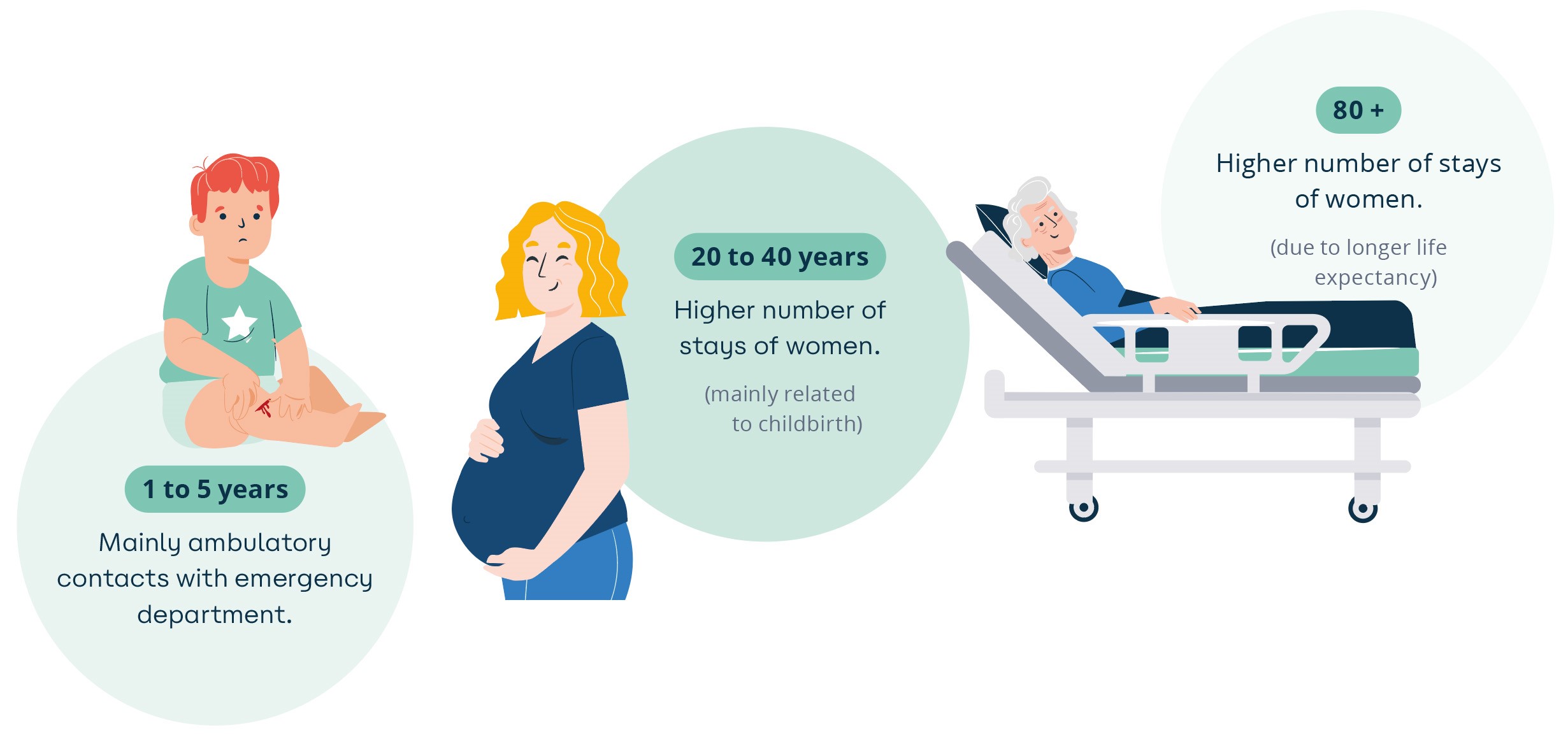Evolution in the number of stays and contacts
In 2012, the total number of hospital stays (which includes classic or day hospitalisationsand ambulatory contacts with emergency departments) was 5,693,465. This number increased to 6,522,643 in 2019. Afterwards, due to the measures regarding the COVID-19 pandemic, we can observe an atypical decline. That decline is still noticeable in 2021, when 6,190,205 stays were recorded. Only the number of day hospitalisations is higher than before the pandemic.
To accurately compare these changes over time, it is necessary to look at the number of stays/contacts per 100,000 inhabitants. From 2012 to 2019, that number increased by 10.6%. This is mainly due to a higher number of day hospitalisations (+19.2%) and ambulatory contacts with emergency departments (+12.9%).
Another lesson is that from 2014 onwards, the number of day hospitalisations have exceeded those of classic hospitalisation. This is in line with the hospital reforms. The goal is to reduce the number of unnecessary overnight stays in hospitals when it is medically safe and socially feasible for the patient. Because of medical innovations, procedures are also less invasive, allowing patients to recover faster and leave the hospital sooner. The shift to more day hospitalisation has several benefits: for example, a lower risk of hospital-acquired infections due to shorter stays and potentially reduced costs for patients and society. In addition, nurses can be deployed elsewhere if the types of care associated with an overnight stay decrease.
Evolution of the number of stays and contacts per 100,000 inhabitants by type of hospitalisation
Number of hospital stays/contacts according to region [1]
In 2021, the total number of stays per 100,000 inhabitants was 51,145 in Flanders, 55,589 in Brussels and 55,263 in Wallonia. A closer look at the 3 regions reveals several differences between them. In general, the rate at which hospital care is used is lower in Flanders than in the other two regions. The number of day hospitalisations is significantly higher and the number of ambulatory contacts with the emergency departments is lower. In the Brussels-Capital Region, the emergency departments are used twice as frequently by out-patients than in the Flemish Region. In the Brussels-Capital Region, classic hospitalisations are used to a lesser degree.
Number of stays per 100,000 inhabitants by type of hospitalisation and by region (2021)
For more information about the origin of patients, visit: https://www.health.belgium.be/fr/rhm-origine-des-patients
Age and gender of patients
In children, we see a higher number of contacts with the hospital between the ages of 1 and 5 years, mainly due to more intensive use of out-patient emergency services. About one-fifth of patients are between 55 and 70 years old. Above the age of 80, we observe a higher total number of hospital stays in women than in men. This is due to their longer life expectancy. The higher use of hospital care by women aged 20 to 40 compared to men in this age group is mainly related to childbirth.
Number of stays and contacts by type of hospitalization, age and gender (2021)
Average length of stay in the case of classic hospitalisation
For years, healthcare policy has promoted the reduction of length of stay to ensure efficiency and safeguard the proper use of hospital capacity. The intention is to achieve this without compromising the quality of care and by taking into account each patient’s specific situation.
In 2021, the average length of stay in an acute department was 4 days[2], in a geriatrics department 13 days and in a maternity and paediatrics department 3 days. Between 2012 and 2021, the average length of stay in the acute care and maternity departments decreased by one day and in the geriatrics service by three days. In the paediatrics department, the average length of stay remained stable.
Average duration of stay per type of service
If we zoom in on the number of days that patients stay in a given department, we find that nearly 60% of acute care stays do not exceed 2 days. In maternity, in 64% of cases, the duration does not exceed 3 days and 86% of stays do not exceed 4 days.6 In geriatric care departments, the average length of stay is longer than in the other departments. For 54% of patients, their stay lasts longer than 10 days. In paediatrics, 62% of children spend no more than two days in hospital.
Duration of stay for classic stays according to the service (2021)
[1]Region in which the patient resides.
[2]Psychiatric and chronic stays are not included in these graphs. Stays longer than 10 days are not shown in the second graph for the sake of readability.



